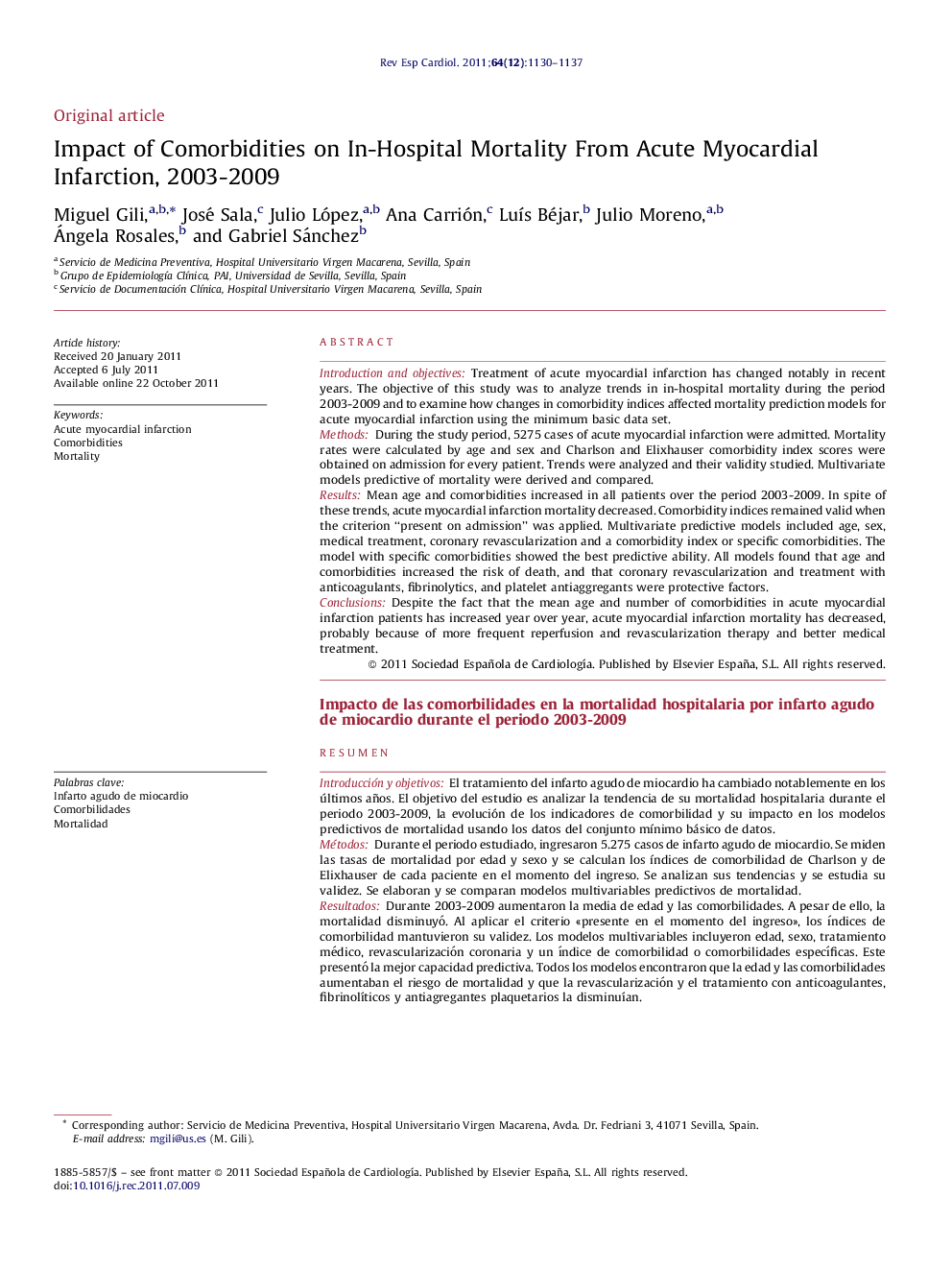| کد مقاله | کد نشریه | سال انتشار | مقاله انگلیسی | نسخه تمام متن |
|---|---|---|---|---|
| 3016730 | 1182094 | 2011 | 8 صفحه PDF | دانلود رایگان |

Introduction and objectivesTreatment of acute myocardial infarction has changed notably in recent years. The objective of this study was to analyze trends in in-hospital mortality during the period 2003-2009 and to examine how changes in comorbidity indices affected mortality prediction models for acute myocardial infarction using the minimum basic data set.MethodsDuring the study period, 5275 cases of acute myocardial infarction were admitted. Mortality rates were calculated by age and sex and Charlson and Elixhauser comorbidity index scores were obtained on admission for every patient. Trends were analyzed and their validity studied. Multivariate models predictive of mortality were derived and compared.ResultsMean age and comorbidities increased in all patients over the period 2003-2009. In spite of these trends, acute myocardial infarction mortality decreased. Comorbidity indices remained valid when the criterion “present on admission” was applied. Multivariate predictive models included age, sex, medical treatment, coronary revascularization and a comorbidity index or specific comorbidities. The model with specific comorbidities showed the best predictive ability. All models found that age and comorbidities increased the risk of death, and that coronary revascularization and treatment with anticoagulants, fibrinolytics, and platelet antiaggregants were protective factors.ConclusionsDespite the fact that the mean age and number of comorbidities in acute myocardial infarction patients has increased year over year, acute myocardial infarction mortality has decreased, probably because of more frequent reperfusion and revascularization therapy and better medical treatment.
ResumenIntroducción y objetivosEl tratamiento del infarto agudo de miocardio ha cambiado notablemente en los últimos años. El objetivo del estudio es analizar la tendencia de su mortalidad hospitalaria durante el periodo 2003-2009, la evolución de los indicadores de comorbilidad y su impacto en los modelos predictivos de mortalidad usando los datos del conjunto mínimo básico de datos.MétodosDurante el periodo estudiado, ingresaron 5.275 casos de infarto agudo de miocardio. Se miden las tasas de mortalidad por edad y sexo y se calculan los índices de comorbilidad de Charlson y de Elixhauser de cada paciente en el momento del ingreso. Se analizan sus tendencias y se estudia su validez. Se elaboran y se comparan modelos multivariables predictivos de mortalidad.ResultadosDurante 2003-2009 aumentaron la media de edad y las comorbilidades. A pesar de ello, la mortalidad disminuyó. Al aplicar el criterio «presente en el momento del ingreso», los índices de comorbilidad mantuvieron su validez. Los modelos multivariables incluyeron edad, sexo, tratamiento médico, revascularización coronaria y un índice de comorbilidad o comorbilidades específicas. Este presentó la mejor capacidad predictiva. Todos los modelos encontraron que la edad y las comorbilidades aumentaban el riesgo de mortalidad y que la revascularización y el tratamiento con anticoagulantes, fibrinolíticos y antiagregantes plaquetarios la disminuían.ConclusionesA pesar de que cada año ingresan pacientes con infarto agudo de miocardio de más edad y con más comorbilidades, su mortalidad va reduciéndose, probablemente por el uso más frecuente de la revascularización coronaria y al mejor tratamiento médico.
Journal: Revista Española de Cardiología (English Edition) - Volume 64, Issue 12, December 2011, Pages 1130–1137